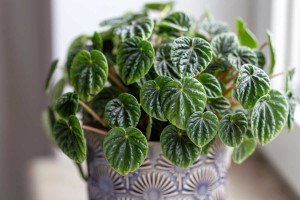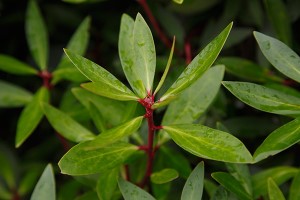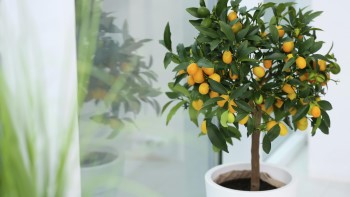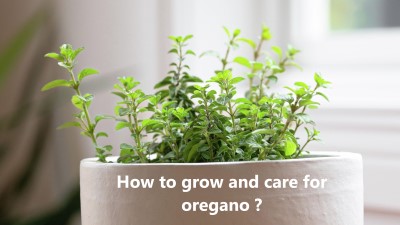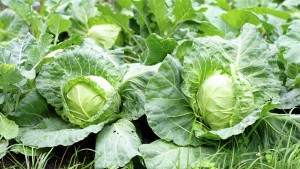- Houseplants
- 4,053
Peperomia plants are becoming increasingly popular for their attractive foliage and easy care requirements. Native to South America, these beautiful plants are a wonderful addition to any indoor garden. From the classic Peperomia obtusifolia to the more unusual frilly-leafed varieties, Peperomia plants can add a unique texture and color to any room.
Here at Garden Pie, we shall look into how to grow and propagate peperomias.
Table of contents [Show]
- 1 What you need to know about peperomias
- 2 Appearance and characteristics of peperomias
- 3 Uses for peperomias
- 4 How to grow Peperomia plants indoors ?
- 5 Caring for peperomias
- 6 How often should you water and feed peperomias ?
- 7 How and when to prune peperomias ?
- 8 Diseases and pests that affect peperomias
- 9 How to propagate peperomias ?
What you need to know about peperomias
Peperomias are a genus of plants in the family Piperaceae, which includes over 1,000 different species. They are native to tropical and subtropical regions of the Americas and Africa, and are popular houseplants.
They are known for their attractive foliage and easy-care requirements, making them ideal for both amateur and experienced gardeners alike.
They have a wide range of shapes, sizes and colors, making them a great choice for adding variety to your indoor garden. They come in both upright and trailing varieties, and their leaves can be oval, heart-shaped or paddle-shaped. Peperomias are also known for their interesting textures, from smooth and glossy to matte and fuzzy.
They prefer bright, indirect light and moderate temperatures. They can tolerate a wide range of lighting conditions, but prefer to be kept out of direct sunlight. Watering should be done when the soil is dry to the touch and the water should be allowed to drain completely before replacing the pot. It's important to avoid overwatering, as this can lead to root rot.
They are also relatively easy to propagate, either through cuttings or division. To propagate by cuttings, simply take a stem that has some leaves attached and remove the lower leaves. Dip the end of the stem in rooting hormone and place it in a pot filled with moist, well-draining soil. Keep the cutting in a warm, humid location and water when the soil is dry to the touch.
Facts about Spider Plants includes:
- Name: peperomia, radiator plant, Peperomia spp., baby rubber plant (Peperomia obtusifolia), watermelon peperomia (Peperomia argyreia), cupid peperomia (Peperomia scandens ‘Variegata’).
- Height: up to 30cm, but trailing forms can grow up to 90cm long.
- Plant type: evergreen perennial.
- Climate: subtropical, tropical or warm frost-free climes; adapts well to being grown indoors.
- Soil: well-drained soil outdoors; premium-quality potting mix blended with perlite indoors.
- Position: partly shaded under trees outdoors; bright, indirect light indoors. Will also grow in medium light conditions.
- Foliage: thick, fleshy leaves in many different sizes, colours and shapes.
- Flowering: slender, tail-like flower spikes.
- Feeding: liquid feed regularly during the warmer months, reduce frequency in winter.
- Watering: water when the top 2.5-5cm of soil is dry.
Appearance and characteristics of peperomias
Peperomias are a delightful group of plants that are popular among houseplant enthusiasts. These attractive and low-maintenance plants add a touch of greenery to any living space, making them a great choice for novice gardeners and experienced botanists alike. From their unique leaf shapes and vibrant colors to their easy-care habits, peperomias are a wonderful addition to any home.
Appearance
- Peperomias are usually small, compact plants with fleshy leaves and stems that are great for container gardening.
- Some species can grow up to 12 inches in height, but most remain small and petite.
- The leaves of peperomias are usually thick and glossy, and come in a variety of shapes and sizes.
- Many species feature vibrant colors like deep red, deep green, or even variegated patterns.
- The leaves of some species may be patterned with silver or pink, creating an interesting contrast.
Characteristics
- They are known for their easy-care habits, and they require minimal attention. They prefer bright, indirect light and should be allowed to dry out between waterings.
- They can be fertilized occasionally with a diluted balanced liquid fertilizer, but this is not necessary.
- The soil should be kept evenly moist, but not soggy, and the pot should be well-draining.
- They are quite hardy and can tolerate a wide range of temperatures, making them a great choice for those living in temperate climates.
- They also make great houseplants, as they are easy to care for and can tolerate low humidity levels.
Uses for peperomias
Peperomias are suitable for a wide range of indoor settings, and offer a number of uses and benefits.
- They are often used as table top plants, as they are small and compact enough to fit on a desk or countertop. Their attractive leaves come in a variety of shapes and sizes, making them a great way to add a pop of color and texture to any room.
- Additionally, peperomias are low-maintenance plants that require minimal care, making them an ideal choice for busy households.
- They are also great for adding humidity to the air. This is especially beneficial for those living in dry climates, such as desert regions. The plants absorb moisture from the air, helping to keep the air in the home feeling comfortable and humid.
- They are also a great choice for hanging baskets. Their trailing foliage makes them ideal for hanging in windows or on walls. The plants are also perfect for terrariums and fairy gardens, as they are small enough to fit in these miniature landscapes.
- Finally, they are often used as an alternative to traditional houseplants. They are an ideal choice for those looking to add greenery to their home without the hassle of dealing with high-maintenance plants.
How to grow Peperomia plants indoors ?
- The first step in growing Peperomia plants is to provide them with the right environment.
- These plants prefer bright, indirect sunlight and a warm environment between 65-85 degrees F.
- They should be planted in a well-draining potting mix such as a mixture of one part peat moss, one part perlite, and one part sterilized soil.
- It is important to water the plants regularly, but be sure to avoid overwatering. Allow the top inch of soil to dry out before giving the plant more water.
- Peperomia plants are low maintenance and easy to care for. They do not need to be fertilized often, as they are slow-growing.
- A balanced fertilizer should be applied every two to three months to ensure the plant receives the necessary nutrients.
- It is also important to prune the plant regularly to encourage new growth and keep it looking its best.
Caring for peperomias
Peperomias are some of the most popular houseplants around. They're easy to care for, come in a wide array of colors and textures, and they're generally quite hardy.
If you've recently added a peperomia to your home, here's what you need to know about caring for it:
- Light: Peperomias prefer bright, indirect light. You can place them near a window or in a room that receives plenty of filtered light. If your peperomia is not getting enough light, its leaves will become pale and may even start to curl.
- Water: Peperomias don't require a lot of water. Water your plant when the top inch of soil is dry. If the soil stays too wet for too long, the plant’s roots will rot.
- Temperature: Peperomias prefer warm temperatures, ideally between 65-80 degrees Fahrenheit. If your home is too cold, your plant may suffer from cold damage.
- Soil: Peperomias require well-draining soil, so it's best to use a potting mix specifically designed for succulents and cacti.
- Fertilizer: Fertilize your peperomia once a month during the growing season (spring and summer) using a balanced liquid fertilizer.
- Pruning: If your peperomia starts to look leggy or out of shape, you can prune it back. Make sure to use sharp, clean scissors or pruners to avoid damaging the plant.
How often should you water and feed peperomias ?
Keeping these plants healthy and vibrant requires proper watering and feeding, so it's important to learn how often you should do these things.
Watering
- When it comes to watering, peperomias have relatively low water needs.
- They can go for a few days at a time without needing to be watered. When you do water them, make sure to use lukewarm water and avoid getting the leaves wet.
- It's also important to let the soil dry out between waterings, as peperomias are prone to root rot if they stay too wet.
- As a general rule of thumb, water your peperomia once every 7-10 days, or when the soil is dry to the touch.
Feeding
- When it comes to feeding, peperomias don't require a lot of fertilizer.
- In fact, they can go for months without it. If you do decide to fertilize your peperomias, use a balanced liquid fertilizer diluted to half-strength and feed them once a month during the growing season (spring and summer).
- During the winter months, fertilizing isn't necessary.
Overall, peperomias are easy to care for and don’t require a lot of fuss. Just remember to water them once every 7-10 days and feed them once a month during the growing season.
With the right care, your peperomias will thrive and bring a bit of life to your home.
How and when to prune peperomias ?
Pruning is an important part of keeping Peperomias healthy and looking their best.
Here's everything you need to know about when and how to prune your peperomia.
When to Prune ?
- The best time to prune your peperomia is in the spring just before the new growth starts.
- This is when the plant is at its most vigorous, so pruning will help encourage the growth of new shoots and leaves.
- Pruning at this time will also help keep the plant in a neat and compact shape.
How to Prune ?
Peperomias are easy to prune as their stems are quite soft and pliable.
- To prune, use a pair of sharp scissors or gardening shears and cut back any overgrown stems or leaves. Avoid cutting too close to the base of the plant as this could damage the stem.
- Instead, prune just above a pair of leaves.
- Also, be sure to remove any dead or damaged leaves and stems. This will help keep the plant healthy and looking its best.
Aftercare
- After pruning, it's important to give your peperomia some extra TLC.
- Give the plant some extra water and place it in bright, indirect sunlight. This will help the plant recover quickly after pruning and encourage the growth of healthy new leaves and stems.
Diseases and pests that affect peperomias
Unfortunately, Peperomias are not immune to diseases and pests. Knowing how to recognize and treat common diseases and pests that affect peperomias can help keep your plant healthy and looking its best.
Diseases
Peperomias are susceptible to several common diseases, including root rot, leaf spot, and powdery mildew.
- Root rot is caused by overwatering and is characterized by soft, brown roots and wilting foliage.
- Leaf spot is caused by fungal infections and is characterized by yellow or brown spots on the leaves.
- Powdery mildew is a white, powdery growth on the leaves and stems of the plant.
Pests
Common pests that affect peperomias include aphids, mealybugs, spider mites, and scale.
- Aphids are small, soft-bodied insects that feed on sap and are typically found on the undersides of leaves. Mealybugs are white, cottony-looking insects that feed on sap and can cause leaves to yellow and die.
- Spider mites are small, eight-legged insects that feed on sap and can cause yellowing and stippling of the leaves.
- Scale are small, hard-shelled insects that feed on sap and can cause yellowing and wilting of the foliage.
Treatment
The best way to treat diseases and pests that affect peperomias is to be proactive.
- Regularly inspect the plant for signs of disease and pest infestation and take action as soon as you notice any problems.
- For diseases, make sure to water your plant properly and prune off any affected foliage.
- For pests, you can use insecticidal soap or neem oil to control populations.
How to propagate peperomias ?
Propagating peperomia plants is a great way to create more plants and add a bit of variety to your collection.
Via division
The most common way to propagate peperomia plants is through division.
To do this:
- Start by carefully removing the plant from its pot.
- Gently shake the soil away from the roots and carefully separate the plant into two or more sections.
- Each section should have at least one stem and some roots.
- Place each division into its own pot with a potting mixture that is specifically formulated for peperomia plants. Water thoroughly and place the pots in a location with bright, indirect sunlight.
Via stem cuttings
Another way to propagate peperomia plants is through stem cuttings.
- Start by cutting a stem about 3 to 4 inches in length and remove any leaves near the bottom of the stem.
- Dip the stem in rooting powder and place it in a potting mixture that is specifically formulated for peperomia plants.
- Water the mixture and place the pot in a warm, bright location with indirect sunlight.
- Be sure to keep the soil consistently moist, but not soggy.
Via leaf cutting
Finally, you can propagate peperomia plants through leaf cutting.
- Start by cutting a healthy leaf from the top of the plant.
- Dip the bottom of the leaf in rooting powder and place it in a potting mixture that is specifically formulated for peperomia plants.
- Water the mixture and place the pot in a warm, bright location with indirect sunlight.
- Be sure to keep the soil consistently moist, but not soggy.
Conclusion
In fact, Peperomia plants are small, decorative, tropical houseplants with thick, succulent-like leaves. They are low maintenance and relatively easy to care for, making them great for novice gardeners.
Here are 16 tips for caring for peperomias:
1. Choose a pot with drainage holes. Peperomias don’t like to sit in wet soil, so make sure your pot has drainage holes to allow the excess water to escape.
2. Use a light, well-draining potting mix. Peperomias prefer a light, well-draining potting mix that is slightly acidic.
3. Provide bright, indirect sunlight. Peperomias like bright, indirect sunlight, so place them near a window or in a spot that gets natural light but not direct sunlight.
4. Water when the soil is dry. Water your peperomias when the top inch of soil is dry. Over-watering can lead to root rot, so make sure the soil has a chance to dry out between waterings.
5. Watch for pests. Peperomias are susceptible to mealybugs, spider mites, and aphids. If you notice any of these pests on your plant, remove them with a damp cloth or insecticidal soap.
6. Prune when necessary. Prune your peperomia if it becomes overgrown or if you want to shape it. Cut back stems to the desired length, being careful not to cut off too much.
7. Fertilize sparingly. Fertilize your peperomia once a month during the growing season with a balanced liquid fertilizer.
8. Repot when necessary. Repot your peperomia every few years to keep the potting mix fresh and provide your plant with more room to grow.
9. Don’t over-pot. Peperomias don’t need a lot of room to spread out, so make sure to use a pot that is slightly larger than the root ball.
10. Propagate from stem cuttings. Propagating your peperomia is a great way to increase your collection. Take stem cuttings, remove the lower leaves, and place the cutting in a glass of water until roots form. Then, transplant the cutting into a pot with soil.
11. Watch for signs of stress. Look for signs of stress such as yellowing leaves, wilting, or drooping. If you notice any of these signs, adjust your care routine accordingly.
12. Don't let the temperature drop too low. Peperomias don’t like cold temperatures, so make sure to keep your plant away from drafty windows and doors.
13. Watch for signs of overwatering. If you notice yellowing leaves or root rot, you may be overwatering your peperomia. Adjust your watering schedule accordingly.
14. Don't expose to too much direct sunlight. Direct sunlight can be too intense for peperomias, so make sure to keep them away from south-facing windows or other areas that get direct sun.
15. Mist occasionally. Peperomias like humid conditions, so give them a light misting once a week to keep them happy.
16. Keep away from pets. Peperomias can be toxic to cats and dogs, so make sure to keep them out of reach of pets.
